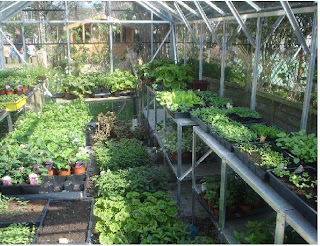

A greenhouse (also called a glasshouse) is a building where plants are cultivated.
A greenhouse is a structure with a glass or plastic roof and frequently glass or plastic walls; it heats up because incoming solar radiation from the sun warms plants, soil, and other things inside the building faster than heat can escape the structure. Air warmed by the heat from hot interior surfaces is retained in the building by the roof and wall. These structures range in size from small sheds to very large buildings.
Greenhouses can be divided into glass greenhouses and plastic greenhouses. Plastics mostly used are PEfilm and multiwall sheet in PC or PMMA. Commercial glass greenhouses are often high tech production facilities for vegetables or flowers. The glass greenhouses are filled with equipment like screening installations, heating, cooling, lighting and may be automatically controlled by a computer.
The glass used for a greenhouse works as a selective transmission medium for different spectral frequencies, and its effect is to trap energy within the greenhouse, which heats both the plants and the ground inside it. This warms the air near the ground, and this air is prevented from rising and flowing away. This can be demonstrated by opening a small window near the roof of a greenhouse: the temperature drops considerably. This principle is the basis of the autovent automatic cooling system. Greenhouses thus work by trapping electromagnetic radiation and preventing convection. A miniature greenhouse is known as a cold frame.
Uses
Greenhouses are often used for growing flowers, vegetables, fruits, and tobacco plants. Bumblebees are the pollinators of choice for most greenhouse pollination, although other types of bees have been used, as well as artificial pollination. This helps the plants to produce more offspring for future plantations.
Besides tobacco, many vegetables and flowers are grown in greenhouses in late winter and early spring, and then transplanted outside as the weather warms. Started plants are usually available for gardeners in farmers' markets at transplanting time.
The closed environment of a greenhouse has its own unique requirements, compared with outdoor production. Pests and diseases, and extremes of heat and humidity, have to be controlled, and irrigation is necessary to provide water. Significant inputs of heat and light may be required, particularly with winter production of warm-weather vegetables. Special greenhouse varieties of certain crops such as tomatoes are generally used for commercial production.
Greenhouses are increasingly important in the food supply of high latitude countries. One of the largest greenhouse complexes in the world is in Almeria, Spain, where greenhouses cover almost 50,000 acres (200 km2).
Greenhouses can allow certain crops to be grown year round such as lettuce and other vegetables.
Greenhouses protect crops from too much heat or cold, shield plants from dust storms and blizzards, and help to keep out pests. Light and temperature control allows greenhouses to turn inarable land into arable land. Greenhouses can feed starving nations where crops can't survive in the harsh deserts and Arctic wastes. Hydroponics can be used in greenhouses as well to make the most use of the interior space.
Biologist John Todd invented a greenhouse that turns sewage into water, through the natural processes of bacteria, plants, and animals.
An agricultural pioneer known as Pete Johnson has recently become a successful pioneer in the use of movable greenhouses in farming.
Source: wikipedia
Saturday, October 31, 2009
GREENHOUSE
Subscribe to:
Post Comments (Atom)





0 comments:
Post a Comment
Untuk pembaca yang menginginkan pembahasan atau kunci jawaban dari post soal silahkan wa 08562908044 (fast respond) | monggo tinggalkan kritik, saran, komentar atau apapun ^_^